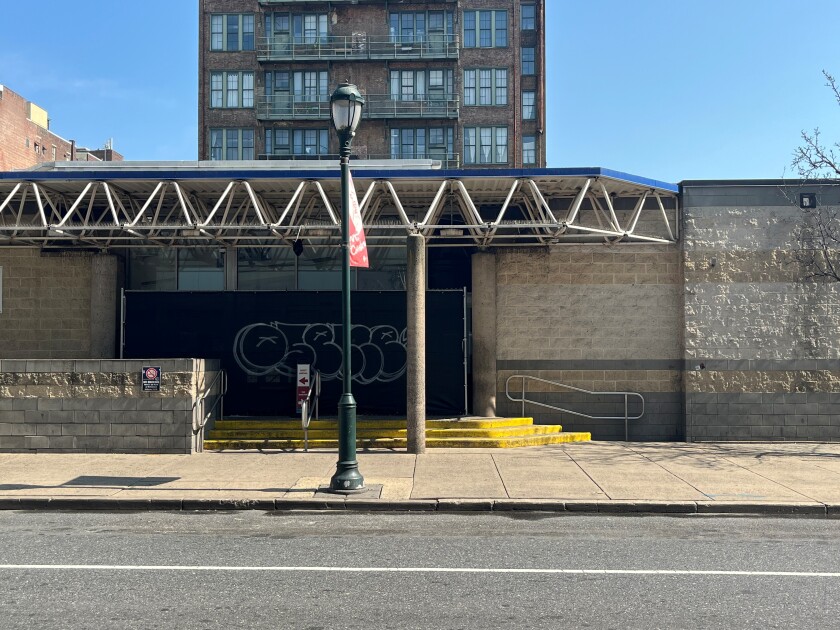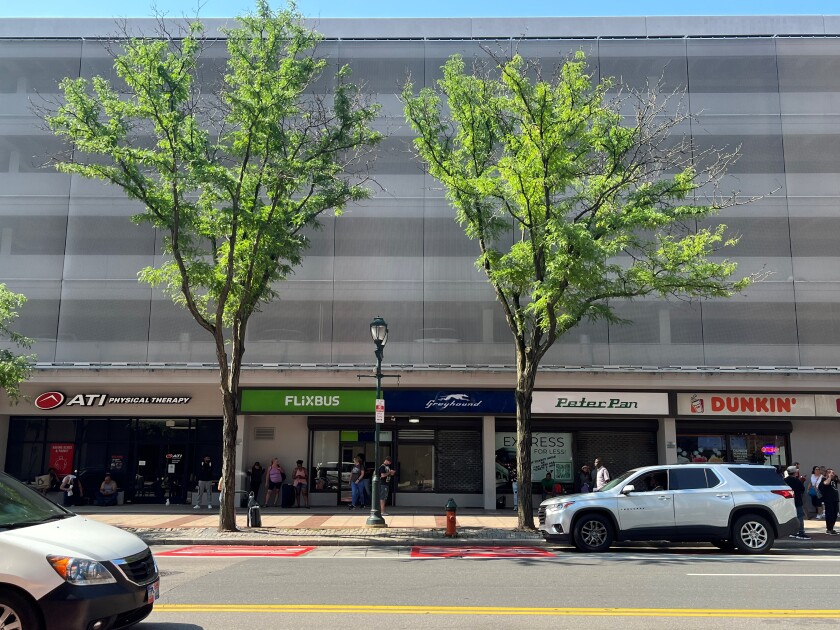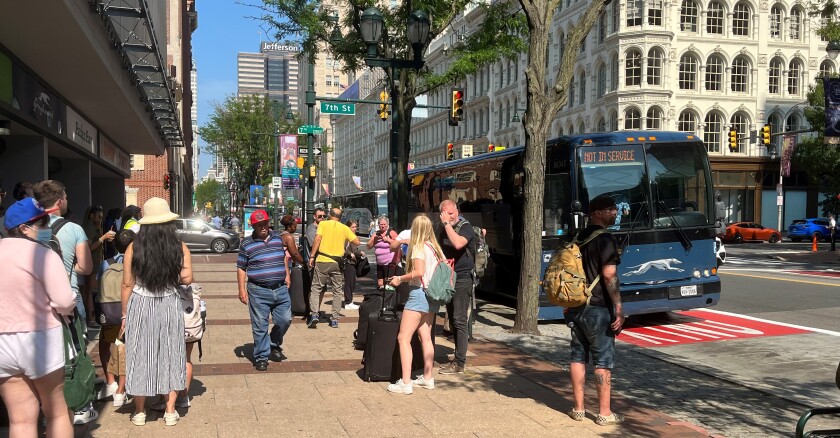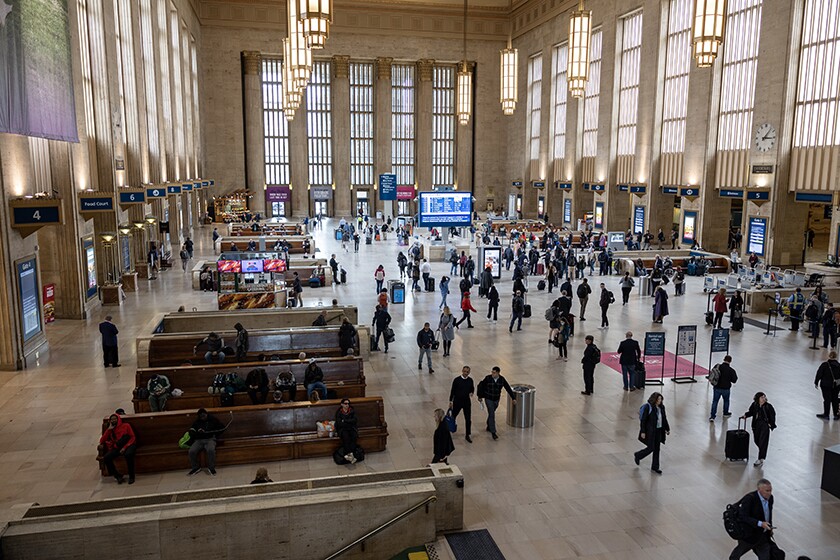In Brief:
Greyhound, long the leading name in intercity bus service, is gradually vacating most of its remaining bus terminals around the country. And riders, and cities, are left holding the bag.
In Philadelphia it started late last month, when Greyhound left its long-term home at a station in Center City and joined a group of curbside bus operators on Market Street near Independence Hall. Suddenly, travelers who’d been accustomed to shelter, shade and restrooms found themselves on the sidewalk, waiting sometimes hours in escalating heat for a bus. With a growing number of buses idling at the curbside, taking up a travel lane that’s supposed to be dedicated to bikes and local public transit buses, city officials had a problem on their hands.
Mark Squilla, a city councilmember whose district includes both the old Greyhound terminal and the new curbside pickup spot, says he’d known for years that the station was eventually going to move, but was caught by surprise by the timing. He soon started getting complaints from a group of federal buildings adjacent to the Market Street pickup, as well as from neighboring businesses, nearby residents and bus riders themselves.
It turned out that Greyhound had signed a short-term lease to join the other curbside services at the ground level of a parking garage that’s slated for eventual redevelopment. The other curbside services, including Peter Pan, Megabus and FlixBus, which now owns Greyhound, have been bounced from place to place over the last several years. The Market Street location — a “humanitarian disaster” and “municipal disgrace” in the words of the Philadelphia Inquirer’s architecture critic — won’t be their permanent home.
“We can’t allow an operation to exist that’s, first of all, not safe, and second of all, is not good for our residents and businesses and their customers. We need to come up with a better solution,” Squilla says.
Philadelphia isn’t alone. Greyhound has left other downtown stations over the last few years in Knoxville, Houston and Columbus, among other places. And more potential closures are on the horizon, according to Joseph Schwieterman, who studies the intercity bus industry and is director of the Chaddick Institute for Metropolitan Development at DePaul University. Officials in cities with remaining Greyhound terminals should prepare to find new ways and new places to accommodate evolving bus services, Schwieterman says.
If they don’t, like in Philadelphia, “Chaos will ensue.”

Why Is Greyhound Leaving Its Downtown Depots?
Many Greyhound stations were established decades ago on valuable downtown real estate. Greyhound's dominance as an intercity bus service began to decline when lower-cost competitors began attracting more riders. Greyhound’s parent company sold the service but not the real estate to FlixBus in 2021. A different company, Twenty Lake Holdings, based in Connecticut, bought much of the remaining property and has begun marketing it for sale in different cities.
Philadelphia’s vacated Greyhound station is owned by a New York-based holding company, according to property records. The property is centrally located, between Center City and Chinatown, with the most permissive zoning designation in the city. It’s on the site of a proposed new arena for the Philadelphia 76ers basketball team, but that is a controversial pitch that’s far from becoming a sure thing.
In the meantime, Squilla says, nearby residents worry the property could become a blight on the neighborhood. He first learned that the station had closed when Chinatown residents called to ask about securing the property. Squilla says he contacted the property owner, but they had no interest in helping out; the group involved with the arena proposal agreed to fence it off temporarily.
Last week, a lone cab driver was resting outside the empty station, bouncing a baseball against the station wall and catching it in a mitt. The driver, who didn’t want to give her name, said it used to be a reliable spot to pick up a fare, going all the way back to when she started driving a cab in the early 1980s. But it was also a seedy place. Not long before it closed, she said, a man had had his throat slit in the bathroom. The story didn’t check out, but it was plausible enough: News reports describe violent attacks at the Greyhound station in Philadelphia and other cities through the years.
Meanwhile, at the new pickup location, riders stood under the awnings of the storefronts in the ground floors of the parking garage, double-checking with each other that they were in the right place — that the bus was just late and they hadn’t missed it. Drivers pulled up to the curb, right on top of the red paint signaling a SEPTA-only lane, and announced the next destination verbally.
Akshay Lulla, a Philadelphia resident, was waiting for a Greyhound bus to Newark to catch a flight to Austin. The bus was way cheaper than Amtrak, he said, and took a lot less time than making the series of connections it would take to get there on local commuter trains. But his bus was already running half an hour late.
"It seems a bit unorganized,” Lulla said. “I have to keep on asking every single bus that comes whether they’re going to the place I want to go.”
How Have Cities Responded to the Situation?
The switch from terminals to curbside pickup can cause problems for cities. A dedicated Greyhound station in Knoxville, Tenn., closed last spring, and the operation has since been moved from place to place. In the fall, it operated briefly from a gas station, but was later told it had to move because of zoning rules. The issue has vexed city officials; a city spokesperson says Greyhound is currently operating from a Knoxville Area Transit stop, and that the city has stayed in close contact with the company about “their need to work expeditiously to find a new site.” The city has negotiated specific operational improvements, like adding security and trash receptacles and reducing passenger transfers and driver changes at the stop. But ultimately the company needs to provide “a secure and sheltered waiting area and sanitary restroom facilities.”
“Based on our communication with Greyhound, we understand that this search is actively underway — and we see evidence that Greyhound is working in good faith to find a new, better location for their operations,” the spokesperson said.
The best approach, says Schwieterman, is for the public sector to establish a central hub for intercity travel that also connects to the local transit system. Even though intercity bus services are operated privately, officials should consider them a complement to and extension of local transit, he says. Good examples of those types of hubs are Boston’s South Station and Union Station in Washington, D.C., where intercity buses run out of an old parking garage connected to Amtrak and the Metro system. Atlanta recently established a new Greyhound station that’s close to MARTA trains as well, and it was built with state money, Schwieterman says. Charlotte is building out a new multimodal hub partly funded by the state as well; Greyhound is currently operating out of the future site of the station, according to a Charlotte Area Transit System spokesperson, and may end up operating out of the same facility as the local buses.

Other big cities will soon be dealing with the issue. Schwieterman is particularly worried about Chicago, where a major intercity hub downtown is being marketed for sale. Closure of the station could mean more people out on the streets at night, in the cold, waiting for buses, he says.
The operation of the hub is too big and complex to support moving things out to the street,” Schwieterman says. “Sadly low-income groups, immigrants and travelers with mobility impairments will take it on the chin and feel the worst of it.”
He’s hoping Chicago will find the money to buy the station and keep it operating as a transit hub. (Chicago city officials did not respond to requests for an interview.) In Philadelphia, Squilla says he’s hoping to have a temporary solution in the next 60 days that will involve removing Greyhound and other bus services from their current location on Market Street. That will involve heavy coordination between city agencies and the bus companies, and potentially the Philadelphia Parking Authority, which could end up hosting the services for a time. The long-term solution is a dedicated hub with all the proper amenities, he says. And that will likely take years to put in place.
"Any time you’re moving something like this to a new location, there are going to be some challenges,” he says.














